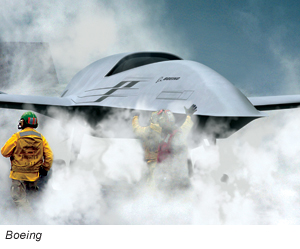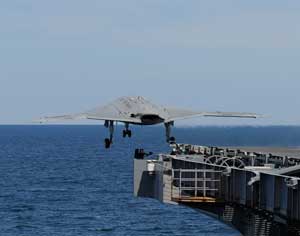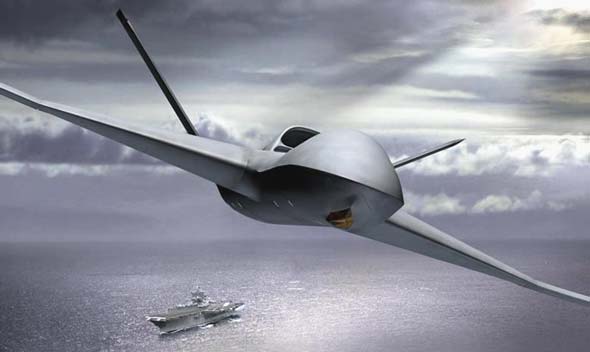
The US Navy has launched a series of preliminary studies expected to lead toward the services’ decision on a future carrier-borne drone currently known as Unmanned Carrier Launched Surveillance and Strike (UCLASS). This drone will be the first unmanned system designed from the ground up to operate from aircraft carriers. Four companies have been awarded $15 million each to conduct a preliminary design review. Follow-on to these studies, a draft Request for Proposal (RFP) is expected to be released by the Navy in September. The formal RFP is expected in 2014. Northrop Grumman, Lockheed Martin, Boeing and General Atomics Aeronautical Systems have awarded funds for the preliminary studies and are expected to compete for the development program. The planned naval drone, likely to be named and designated by year’s end, is expected to be one of the largest unmanned aerial systems programs of the decade.

The Navy recently decided to drop some of the more demanding requirements, thus reducing cost and technical risks that could affect the program in the near term. Former chief of naval operations US Navy Adm Gary Roughead recently criticised the programme for reducing the requirements for the combat ISR drone. Roughhead claimed the navy have diluted the aircraft capabilities, particularly in removing its aerial refuelling capability, and sharply reducing its low observables requirements. Furthermore, payload required was substantially reduced, compared to earlier plans. In response to Adm. Roughead’s claims Pentagon sources commented that the Joint RequirementsOversight Council (JROC) had not diluted the requirements. “I believe what happened with UCLASS was a refinement and clarity of that program that affords us what we really have to have at a value that [the Department of Defense]—and specifically the Navy—are willing to invest in to get to that capability level,” Dyke Weatherington, the Pentagon’s director of unmanned warfare and intelligence, surveillance, and reconnaissance (ISR) said. “What resulted were the most critical needs that the Navy had with a plan to grow that ability as much as we could.” Weatherington said, adding DOD “can’t afford to start programs that we can’t finish.” USNI News reported.
“The requirements were shifted for UCLASS by actually increasing them in some areas and decreasing them in others to get a different mix. Everyone seems to be in agreement with the direction the programme is heading, which should put an affordable, capable platform on carrier flight decks that will expand the navy’s ability to project power within the full joint portfolio of unmanned systems.”
According to Navy Rear Admiral Mathias W. Winter, the Naval Air Systems Command program executive officer for unmanned aviation and strike weapons, the selection of the platform is expected in 2015, with the development phase taking about six years to mature into an operational system. The Navy estimates it could spend up to $2.3 billion on UCLASS between 2013 and 2017. While the Navy is expected to select a prime contractor for the air vehicle, the program office will maintain full control of the system acting as Lead System Integrator, managing the command-and-control segment linking the carrier control center and airborne aircraft, as well as the preparation of the carrier to receive and operate those new unmanned systems. The Navy has not decided how many platforms will be bought, such a decision will be taken after the specific platform is selected and the Navy will be able to assess how many aircraft are necessary to maintain the necessary orbits. The Navy is hoping that some of the advanced capabilities would be addressed in those preliminary offers, positioning the bidders in an advantage compared to others.

The key performance parameters (KPPs) of the planned UCLASS called for an unmanned aircraft that had a ordnance payload capability of 1,000 pounds, less than quarter of the 4,500-pound ordinance capacity of the two Northrop Grumman X-47Bs used as part of the service’s Unmanned Combat Air System demonstrator (UCAS-D) program. The unit cost for the aircrafts, less research and development, and operations and maintenance cost (known as recurring flyaway cost), required to conduct a 600 nautical mile persistent orbit shall not exceed $150 million, the UCLASS KPPs indicated.
Part of the challenge of integrating such system will be its integration with an aircraft carrier’s normal deck cycle — the schedule whereby aircraft are launched and are recovered on the ship’s flight deck. That cycle would require flight endurance of 12 hours or more. Sustaining long missions required aerial refueling for the drones as well as supporting other drones with ‘buddy refueling’ capability.

However, the Navy is currently focusing on a platform that will have limited stealth capability, allowing the drone to operate in restrictive environments but not in ‘denied airspace’, as a fully capable stealth aircraft would. It will have a primary Intelligence, Surveillance and Reconnaissance (ISR) role with secondary strike capability, equivalent to that provided by the Air Forces’ Predator platform. The initial configuration will also lack air-refueling capability, which will limit its operational deployment on long endurance missions, as well as reducing the payload weight such an aircraft could carry on a mission. Originally Northrop Grumman said the X-47 would be able to fly missions loaded with 24 small diameter bombs (representing weapons carrying capacity of about three tons). However, the present UCLASS requirements call for a total payload of less than half (1,360kg) of which only 454kg would be cleared for air/ground weapons (representing two 500 pound JDAMs or four SDB)
The relaxed requirements would favor two of the potential bidders, General Atomics and Boeing, that have prepared platforms to address moderate stealth capabilities. Lockheed Martin and Northrop Grumman are pitching full stealth capabilities, and are seemingly sticking to these designs, hopeful to exceed the baseline requirement and meet the objective goal of operations in anti access area denial (A2AD) environment. Originally the UCLASS was considered to be capable of operating under such conditions, carrying much more armament internally, and have an integral aerial refueling, thus providing the Carrier Air Group with transformational strike and ISR capabilities.
According to industry sources the Navy will likely select a cost-plus contract to minimize the amount of risk put on the contractor while developing the system. However, cost-plus would make it more difficult for the Navy to grade bids, and prioritize technological advancement for the threshold requirements and longer term objective.





















